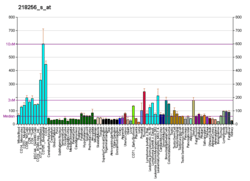Nucleoporin 54
Nucleoporin 54 (Nup54) is a protein that in humans is encoded by the NUP54 gene.[5][6]
Function
The nuclear envelope creates distinct nuclear and cytoplasmic compartments in eukaryotic cells. It consists of two concentric membranes perforated by nuclear pores, large protein complexes that form aqueous channels to regulate the flow of macromolecules between the nucleus and the cytoplasm. These complexes are composed of at least 100 different polypeptide subunits, many of which belong to the nucleoporin family. This gene encodes a member of the phe-gly (FG) repeat-containing nucleoporin subset.[6]
References
- 1 2 3 GRCh38: Ensembl release 89: ENSG00000138750 - Ensembl, May 2017
- 1 2 3 GRCm38: Ensembl release 89: ENSMUSG00000034826 - Ensembl, May 2017
- ↑ "Human PubMed Reference:".
- ↑ "Mouse PubMed Reference:".
- ↑ Hu T, Guan T, Gerace L (Sep 1996). "Molecular and functional characterization of the p62 complex, an assembly of nuclear pore complex glycoproteins". J Cell Biol. 134 (3): 589–601. doi:10.1083/jcb.134.3.589. PMC 2120945. PMID 8707840.
- 1 2 "Entrez Gene: NUP54 nucleoporin 54kDa".
Further reading
- Stoffler D, Fahrenkrog B, Aebi U (1999). "The nuclear pore complex: from molecular architecture to functional dynamics". Curr. Opin. Cell Biol. 11 (3): 391–401. doi:10.1016/S0955-0674(99)80055-6. PMID 10395558.
- Bodoor K, Shaikh S, Enarson P, Chowdhury S, Salina D, Raharjo WH, Burke B (1999). "Function and assembly of nuclear pore complex proteins". Biochem. Cell Biol. 77 (4): 321–329. doi:10.1139/bcb-77-4-321. PMID 10546895.
- Finlay DR, Meier E, Bradley P, Horecka J, Forbes DJ (1991). "A complex of nuclear pore proteins required for pore function". J. Cell Biol. 114 (1): 169–183. doi:10.1083/jcb.114.1.169. PMC 2289063. PMID 2050741.
- Buss F, Stewart M (1995). "Macromolecular interactions in the nucleoporin p62 complex of rat nuclear pores: binding of nucleoporin p54 to the rod domain of p62". J. Cell Biol. 128 (3): 251–261. doi:10.1083/jcb.128.3.251. PMC 2120351. PMID 7531196.
- Maruyama K, Sugano S (1994). "Oligo-capping: a simple method to replace the cap structure of eukaryotic mRNAs with oligoribonucleotides". Gene. 138 (1–2): 171–174. doi:10.1016/0378-1119(94)90802-8. PMID 8125298.
- Guan T, Müller S, Klier G, Panté N, Blevitt JM, Haner M, Paschal B, Aebi U, Gerace L (1996). "Structural analysis of the p62 complex, an assembly of O-linked glycoproteins that localizes near the central gated channel of the nuclear pore complex". Mol. Biol. Cell. 6 (11): 1591–1603. doi:10.1091/mbc.6.11.1591. PMC 301313. PMID 8589458.
- Suzuki Y, Yoshitomo-Nakagawa K, Maruyama K, Suyama A, Sugano S (1997). "Construction and characterization of a full length-enriched and a 5'-end-enriched cDNA library". Gene. 200 (1–2): 149–156. doi:10.1016/S0378-1119(97)00411-3. PMID 9373149.
- Popov S, Rexach M, Ratner L, Blobel G, Bukrinsky M (1998). "Viral protein R regulates docking of the HIV-1 preintegration complex to the nuclear pore complex". J. Biol. Chem. 273 (21): 13347–13352. doi:10.1074/jbc.273.21.13347. PMID 9582382.
- Hu RM, Han ZG, Song HD, Peng YD, Huang QH, Ren SX, Gu YJ, Huang CH, Li YB, Jiang CL, Fu G, Zhang QH, Gu BW, Dai M, Mao YF, Gao GF, Rong R, Ye M, Zhou J, Xu SH, Gu J, Shi JX, Jin WR, Zhang CK, Wu TM, Huang GY, Chen Z, Chen MD, Chen JL (2000). "Gene expression profiling in the human hypothalamus-pituitary-adrenal axis and full-length cDNA cloning". Proc. Natl. Acad. Sci. U.S.A. 97 (17): 9543–9548. doi:10.1073/pnas.160270997. PMC 16901. PMID 10931946.
This article is issued from
Wikipedia.
The text is licensed under Creative Commons - Attribution - Sharealike.
Additional terms may apply for the media files.




